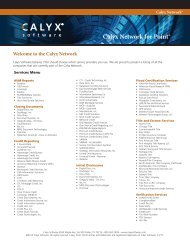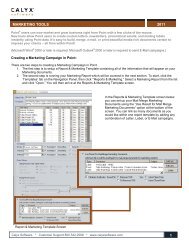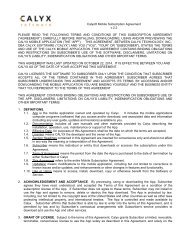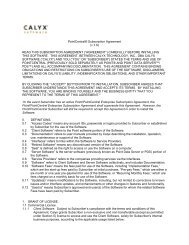Originator Compensation and the Fed Rule ... - Calyx Software
Originator Compensation and the Fed Rule ... - Calyx Software
Originator Compensation and the Fed Rule ... - Calyx Software
You also want an ePaper? Increase the reach of your titles
YUMPU automatically turns print PDFs into web optimized ePapers that Google loves.
<strong>Originator</strong> <strong>Compensation</strong> <strong>and</strong> <strong>the</strong> <strong>Fed</strong> <strong>Rule</strong> Webinar Q &A<br />
Disclosure of more than 4 is not required. The disclosure requirement is, in my opinion, still<br />
troublesome since it requires more paper.<br />
3. If <strong>the</strong> comp is different but <strong>the</strong> interest rate is <strong>the</strong> same, say on 30 yr fixed loans, is that safe harbor?<br />
It is not safe harbor, but it from your question, it does not appear to be steering -- if all of <strong>the</strong><br />
considerations are <strong>the</strong> same. For instance, <strong>the</strong> compensation might be more because <strong>the</strong> loan contains<br />
a prepayment penalty. In that instance, it might be steering is you convinced <strong>the</strong> customer to take that<br />
option.<br />
Steering<br />
1. I don't underst<strong>and</strong> this steering rule. If you say <strong>the</strong> LO can make 2pt on YSP, <strong>the</strong>n <strong>the</strong> ONLY rate <strong>the</strong><br />
LO can offer to borrower is <strong>the</strong> one with 2pt. YSP? The steering rule addresses <strong>the</strong> originator<br />
influencing a consumer to take a specific loan product because it benefits <strong>the</strong> originator. So if you had<br />
an agreement with creditor A which paid your company 2% on a 30 fixed rate loan, <strong>and</strong> an agreement<br />
with creditor B which paid your company 2.25% on <strong>the</strong> same loan; if creditor B was 1/8th higher in<br />
rate <strong>and</strong> if you convinced your customer to go with creditor B; you could be guilty of steering.<br />
2. As a broker, one has lenders who do a great job from underwriting to closing <strong>and</strong> o<strong>the</strong>rs who are<br />
terrible. If <strong>the</strong> terrible wholesale lender has better rates, what does <strong>the</strong> steering provision require<br />
you to do? If you explain that to <strong>the</strong> customer <strong>and</strong> if <strong>the</strong> customer decides to go with <strong>the</strong> lender you<br />
recommend, even though <strong>the</strong>ir cost might be higher, <strong>the</strong>n it is not steering. Just document it, <strong>and</strong> have<br />
<strong>the</strong> customer sign a statement to that effect. I personally think you will have a difficult time defending<br />
<strong>the</strong> fact that you regularly do business with a company who does “terrible” underwriting. It seems to<br />
me that this is one effect of <strong>the</strong> <strong>Rule</strong>. You should cut off business relationships with creditors who are<br />
not performing well. Then this scenario is not an issue.<br />
3. What if we know our best priced lender (for <strong>the</strong> consumer) has a 2 month turn time, but our client<br />
needs to close sooner than that? Can we go with a FASTER but worse priced lender? If <strong>the</strong> choice is<br />
disclosed to <strong>the</strong> consumer, <strong>and</strong> if <strong>the</strong> consumer decides that it is in <strong>the</strong>ir interest to use a lender with<br />
faster turn times, <strong>the</strong>n it is fine. (1) You should disclose. And (2) you should document.<br />
4. How will <strong>the</strong> policing of a broker work if a guy can pick creditor A to price at 3.0, Creditor B at 2.0<br />
<strong>and</strong> Creditor C at 1.0; <strong>and</strong> <strong>the</strong>n <strong>the</strong> originator sends all of his clients to Creditor A because he makes<br />
<strong>the</strong> most? Can I do that on <strong>the</strong> banker side with my loan officers <strong>and</strong> <strong>the</strong>y can simply pick <strong>the</strong>ir comp<br />
package buy investor? The <strong>Fed</strong>eral Reserve Board Interim <strong>Rule</strong> on <strong>Originator</strong> <strong>Compensation</strong> does not<br />
work <strong>the</strong> way you describe. It is up to <strong>the</strong> consumer to decide which loan option <strong>and</strong> creditor is in <strong>the</strong>ir<br />
interest. If an originator places a consumer in a program which pays <strong>the</strong> originator more but benefits<br />
<strong>the</strong> consumer less, it is steering.<br />
5. Doesn’t <strong>the</strong> consumer need to have a choice of loans not investor? i.e. A 30 yr vs. 3/1 ARM not<br />
CHASE vs. WELLS at <strong>the</strong> same rate? The <strong>Rule</strong> requires disclosure of a “significant number” of<br />
creditors as well as rates, etcetera. But this is only required if you are seeking <strong>the</strong> Safe Harbor<br />
provision.<br />
_____________________________________________________________________________________________________<br />
Questions answered are not intended as legal advice.<br />
Please consult legal counsel for answers specific to your circumstance. 10












